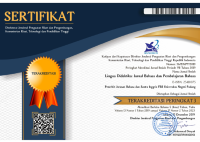CULTURE, ITS DIMENSIONS AND IMPLICATIONS TO THE TEACHING OF ENGLISH
 ),
), (1) English Department Faculty of Languages and Arts Universitas Negeri Padang Jl. Prof. Dr. Hamka Air Tawar Padang, 25131 Sumatera Barat, Indonesia
 Corresponding Author
Corresponding Author
Copyright (c) 2016 Lingua Didaktika: Jurnal Bahasa dan Pembelajaran Bahasa
DOI : https://doi.org/10.24036/ld.v10i1.6331
Full Text:
 Language : en
Language : en
Abstract
Culture is an important aspect in learning a foreign language. This paper discusses three main conceptual issues: the concept of culture, its dimensions, and its implication to the teaching of English. In a broader sense, culture umbrellas arts, music, literary works, scientific findings, and other human beings’ creations. In a narrower sense, culture covers habits, customs, and social behaviours of a society. Four cultural dimensions: individualism, collectivism, high-context, and low-context are discussed. Deductive and inductive methods of reasoning are also discussed. In context of the teaching of English, culture is classified into local culture, foreign culture, and academic culture. Local culture refers to values and norms shared by the students who learn English as a foreign language. Foreign culture is the beliefs, norms, and values of the target language. Academic culture is the norms and values practiced in academic life. This paper strongly argues that the teaching of English as a foreign language should be based on local cultural values and norms. Language functions to express thoughts and culture. Therefore, English is used as an instrument to express thoughts and culture of learners who learn English.
Keyword: culture, English language teaching, academic culture.
Keywords
References
Allen, E.D and R.M. Vallette 1977, Classroom Techniques: Foreign Languages and English as a Second language, Harcourt Brace Javanovich, New York.
Alwasilah, A.C. 1991, Cultural Transfer in Communication: A Qualitative Study of Indonesian Students in U.S. Academic settings, Ph.D. Dissertation, Indiana University.
Brislin, R. 1993, Understanding Cultures’ Influences on Behavior, Harcourt Brace College Publishers, Toronto.
Cameron, Deborah. 1997. ‘Demythologizing Sociolinguistics’, in Sociolinguistics: A Reader and Coursebook, Coupland and Jaworski, eds, Antony Rowe Ltd, London.
Gibson, W. 1996, ‘Tough, Sweet and Stuff: An Essay on Modern American Prose styles’, In Culture and Interpersonal Communication, eds. W.B. Gundykunst et al., 1988, sage, Beverly Hills.
Gundykunst, W. and Kim, Y. 1984, Communicating with Strangers, Random House, New York.
Gundykunst, William. B et al. 1988, Culture and Interpersonal Communication, Sage, Beverly Hills.
Hall, E.T. 1976, Beyond Culture, Doubleday, New York.
Herskovits, M. 1955, Cultural Anthropology, Knopf, New York.
Hinds, J. 1987, ‘Reader Versus Writer Responsibility: A New Typology’, in Writing Across Languages: An Analysis of L2 Text, eds. U. Connor and R.B. Kaplan, Addison-Wesley Publishing Co, Reading, Mass.
Hofstede, G. 1980, Culture’s Consequence: International Differences in Work-Related Values, Sage, Beverly Hills.
Hofstede, G. and M. Bond 1984, ‘Hofstede’s Culture Dimensions: An Independent Validation Using Rokeach’s Value Survey’, Journal of Cross-Cultural Psychology, vol. 15, pp. 417-433.
Honna, N. 1995, ‘English in Japanese Society: Language Within Language’, Journal of Multilingual and Multicultural Development, vol. 16, no. 1 &2, pp. 45-62.
Hppia-news group, November 26, 1999.
Hui, C. and Triandis, H. 1986, ‘Individualism-Collectivism: A Study of Cross-Cultural Researchers’, Journal of Cross-Cultural Psychology, vol. 7, pp. 225-248.
Hymes, D.H. 1974, Foundations in Sociolinguistics: An Ethnographic Approach, University of Pennsylvania Press, Pennsylvania.
Jin, L. and M. Cortazzi 1998, ‘ The culture of the Learner Brings: A Bridge or a Barrier?’, in Language Learning in Intercultural Perspective, eds. M. Byram and M. Fleming, Cambridge University Press, Cambridge.
Katriel, T. 1986, Talking Straight: Dugri Speech in Israeli Saba Culture, Cambridge University Press, Cambridge.
Kirkpatrick, A. 1995, ‘Chinese Rhetoric: Methods of Argument’, Multilingua, vol. 14, no. 3, pp. 271-295.
McCarthy, M. and R. Carter1994, Language as Discourse: Perspectives for Language Teaching, Longman, London.
Okabe, R. 1983. ‘Cultural Assumptions of East and West: Japan and the United States’, in Intercultural Communication Theory, ed. W. Gundykunst. Beverly Hills: Sage.
Park, M. 1979, Communication Styles in Two Different Cultures: Korean and American, Han Shin Publishing Company, Seoul, Korea.
Shen, C. 1995, ‘Cultural Components in the Teaching of Asian Languages’, ARAL, vol. 12, pp. 153-168.
Scollon, R. and S.W. Scollon 1991, ‘Topic Confusion in English-Asian Discourse’, World Englishes, vol. 10, no. 2, pp. 113-125.
Scollon, R. and S.W. Scollon 1995, Intercultural Communication, Basil Blackwell Ltd, Oxford.
Suseno, F.M. 1996, Etika Jawa: Sebuah Analisa Falsafi tentang Kebijaksanaan Hidup Jawa, Gramedia Pustaka Utama, Jakarta.
Tyler, A. and C. Davies 1990, ‘Cross-linguistic Communication Missteps’, Text, vol. 10, no. 4, pp. 385-411.
Wierzbicka, A. 1994, ‘Cultural Script: A New Approach to the Study of Cross-Cultural Communication’, in Language Contact and Language Conflict, ed. M. Putz, John Benjamins Publishing Company, Amsterdam.
Zhu, Hua. 2014. “Intercultural Communication”, in Li, Wei (Ed.), Applied Linguistics, Wiley Blackwell.
 Article Metrics
Article Metrics
 Abstract Views : 741 times
Abstract Views : 741 times
 PDF Downloaded : 220 times
PDF Downloaded : 220 times
Refbacks
- There are currently no refbacks.
Copyright (c) 2016 Lingua Didaktika: Jurnal Bahasa dan Pembelajaran Bahasa









